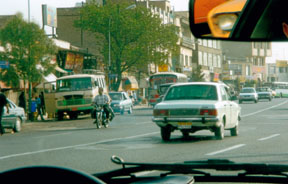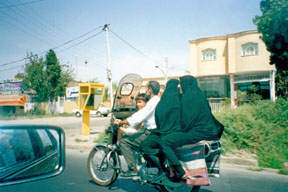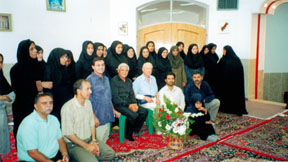|
Web Exclusives: PawPlus March 8, 2006: Encountering
Iran By Henry Posner Jr. ’41 The first thing we saw was a dark armored vehicle with a swivel-mount automatic machine gun manned by a helmeted soldier. Closer to the driver were two more soldiers, clutching automatic weapons pointed outward. They were already traveling at high speed, some 50 yards off our port wing, when we spotted them moments after our Iran Air jet touched down at Tehran airport. As the plane slowed and turned toward its gate, the vehicle maintained its position on our flank. When we stepped out of the plane into the 86-degree heat of a July night, there they were, our military escort, even more impressively armed than I had realized from my window seat. It was to be a recurrent realization over the next seven days.
A street scene in Tehran
I had accepted the invitation of an Iranian-American friend, John Ghaznavi, to join him on a trip from Pittsburgh – where we both live and work – to his native village, Rahagh, near the city of Kashan in central Iran. We had traveled together to Doha, Qatar the year before on an institutional mission, and I knew him to be a lively and resourceful companion. John proved himself within minutes now. The Iranian “paperwork” for my visa had not cleared, said the uniformed customs officer in the terminal; after 30 hours en route, I could not be permitted to enter the country. John, whose father was a tribal chief and community leader in his region many years ago, has been generous with his former villagers and is frequently called for consultation by Iranian government officials. Now he reached for his phone and called the Iranian foreign minister, rousing him from bed. Within the hour we were on our way. Our reception at John’s sister’s house in Tehran couldn’t have been more different. Mitra, a younger sister, met us at the door and led us inside. Joined by her family, we sipped aromatic tea, a sugar cube clenched (precariously in my case) between the teeth according to custom. Everyone wanted to talk – in Farsi – but although it was now well past midnight, we proceeded to a vast dinner of fruit, nuts, rice, fava beans, chiraz leaf and onion salad, chicken, lamb kabobs, and beef, the meats cooked long and slowly so they could be pulled apart with only a fork and spoon (knives were not used). After dinner the conversation and tea continued until 3 a.m. The hour, which I took to be the consequence of our arrival, proved instead to be the pattern. Rarely did we get more than four hours of sleep.
An Iranian family traveling together. Mitra’s son, Ali, whom I guessed to be about 40, spoke excellent English. Exceptionally well-informed, he was a warm and lively conversationalist who engaged me immediately. I learned later that when he was young he had been imprisoned for four years – and beaten in prison – after being caught reading forbidden political material with a friend. The friend was executed. The next day, with Ali driving, John and I left for Qom, Kashan, Rahagh, and later Isfahan. To avoid the impenetrable traffic of Tehran and the 105-degree midday temperatures, we had risen at 5 a.m. Even at dawn a substantial proportion of Iran’s 70 million people (more than France or Italy) appeared to be on the road. At the wheel, Ali had the disconcerting habit of looking at the passenger he was addressing, regardless of speed, traffic, or seating arrangement, while simultaneously talking on his cell phone. Other drivers appeared to be doing the same. Thankfully, the highways were broad and modern, although the price of gasoline (40 cents a gallon) seemed all too encouraging. I was particularly surprised, though, to notice that street signs, billboards, and other signs were in English as well as Farsi. That implicit embrace of Western culture, I came to realize, pervades Iran in ways that were not peculiar to John’s relatives or an American’s presence. It isn’t just that the women wear Western clothes and jewelry at home, donning the chador only to go out in public. Or that alcohol is freely available in homes, but never in public places. American T-shirts, American music, and other Western styles are manifestly popular with the people on the streets. And those people are overwhelmingly young: Two-thirds of the population is under 26. More striking than their age, though, was a readiness to distinguish between the personal and the governmental. I repeatedly got the sense that the Iranians like Americans – but not the American government. One of our stops was at a small school in Kashan for abandoned girls, one of two that John founded and continues to support. Many, though not all, of the girls had physical or mental disabilities. John knows how harsh life in Iran can be. More than 20 years ago, he and his American wife found a sickly baby girl by the roadside, where she had been left to die. With great and protracted difficulty they managed to bring her to the United States for medical treatment. Now their healthy adopted daughter, she lives in Los Angeles and works in the film industry.
Henry Posner Jr. ’41, seated center in light blue shirt, at the school for abandoned girls in Kashan founded by his Iranian-American host, seated to Posner’s right. It was hot when we arrived at the family farm in Rahagh; so was the welcoming tea, served by John’s older sister, Fati. John’s grandfather had 15 wives, so there was no shortage of relatives on hand to greet us. A widow, Fati manages the farm, which employs as many as 80 at harvest time. Once word got out that John was there, the elders from nearby villages came to pay formal respects, drink tea, and ask for favors. Such traditional rituals notwithstanding, the television was always on, as at Mitra’s house, usually tuned to one of the 17 U.S. channels received via satellite. The embracing receptions and the palpable enjoyment of things American was oddly out of synch with official signs and signals I had seen along our route—on billboards, in the papers—from a government that seemed perpetually angry. Police, conspicuously armed, were virtually everywhere. The walls of many city buildings bore huge portraits of the dead from the Iran-Iraq war, adding a military, funereal scrim to the public scenery. On the highways we passed TV towers and TV station buildings, all with armed guards and gun emplacements, and a nuclear facility guarded by soldiers and heavy weapons. But those reminders of official, governmental presence seemed
strangely detached from the life I encountered. Along with usual
souvenirs of this harsh, beautiful, and endearing land, such as
pictures delicately painted on camel bone, I brought home the recollection
of warm tea and an eagerness for engagement.
After graduating, Henry Posner Jr. ’41 was recruited to help develop solid fuel for rockets and take-off boosters for B-17 and B-29 bombers. In 1944 he joined the Manhattan Project, the secret program at Columbia University to develop the atomic bomb. When the war ended, he returned to Pittsburgh to teach chemistry at the University of Pittsburgh while earning a master’s degree. In 1946 he joined the Pittsburgh Outdoor Advertising Corp., managed and partly owned by his father. In 1952 he and his father bought the Morton Advertising Co. in Baltimore. After 23 years as chairman of Pittsburgh Outdoor, Posner went on to help develop and manage more than 20 companies. Active as chairman of his investment company, The Hawthorne Group, Posner in recent years has devoted considerable attention to charitable gifts, primarily benefiting education and health care.
|



